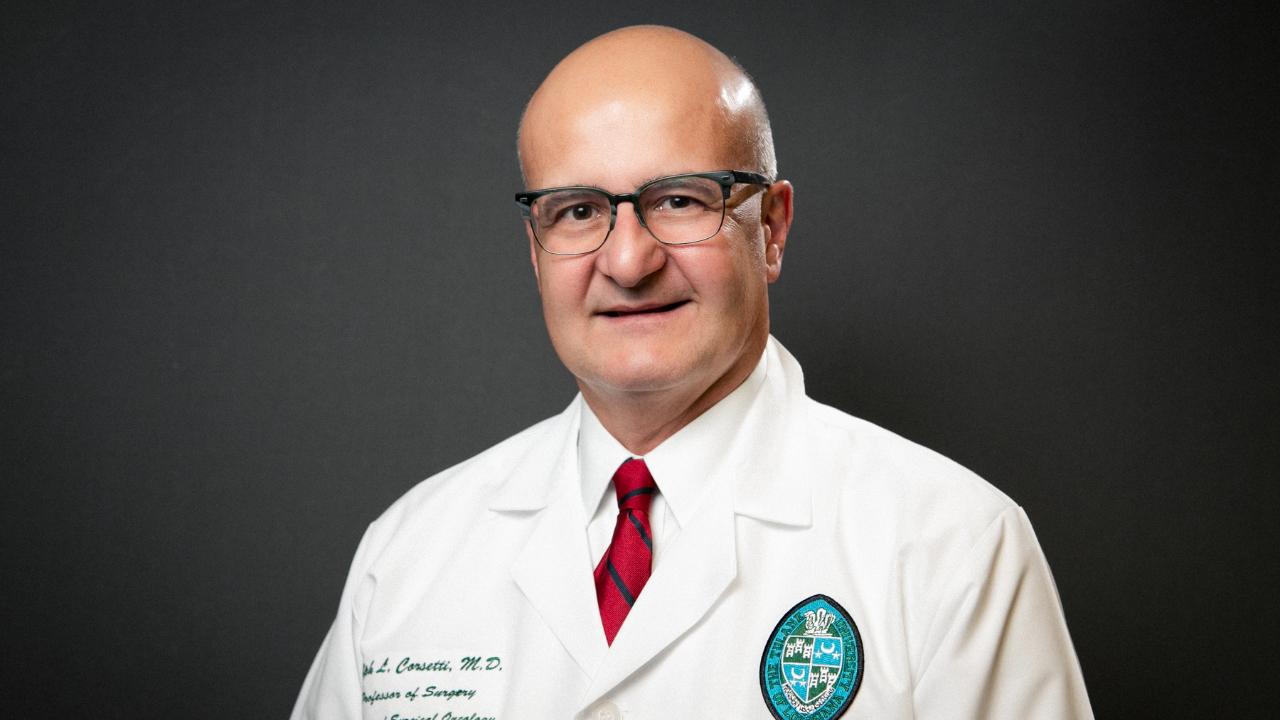New MRI-Guided Wireless Tumor Localization Revolutionizing Breast Conservation Surgery at Tulane
Many women diagnosed with early-stage breast cancer opt for breast-conserving surgery or lumpectomy. For those whose tumors are nonpalpable – not able to be felt – pre-operative localization of the tumor is necessary so the surgeon can find and remove the cancerous tissue.
Image-guided wire localization (WGL) – involving the placement of an external wire into the tumor – was once the preferred technique. However, this option presents several challenges. "Patient stress and discomfort are chief among them," said Ralph Corsetti, MD, the Edward G. Schleider Chair in Surgical Oncology. "The patient would have to undergo a separate pre-operative procedure on the day of surgery during which a wire would be inserted into the breast and guided to the tumor by the radiology team." The surgeon would later follow this wire during surgery and remove the tumor and any affected adjoining tissue.
Having to undergo multiple procedures on the same day, limitations in movement from when the wire is placed until the surgical procedure begins, and the visual of an external wire are all challenges for patients who undergo this localization technique. Wires can also migrate, making it difficult to remove all of the cancerous tissue and possibly setting up the need for a second surgery.
Additionally, same-day wire localization requires coordination of schedules for both the radiology and surgical teams, often resulting in delays in procedure start times. And it limits the ability of the surgeon to pre-plan his surgical approach.
Over the last decade, alternatives to WGL have emerged. "There are several wireless technologies; all have pros and cons," said Corsetti. "The one we have been using for the past five years – the Savi Scout® – has the most pros and the fewest cons."
The Savi Scout® is a radar detection system for the pre-surgical, wire-free localization of breast tumors. It uses a reflector that is about the size of a grain of rice that can be implanted into a breast tumor via a hollow needle-like sheath at any time before surgery. The radiologist uses image guidance to help appropriately position the pellet within the tumor. The reflector is not radioactive, it's not visible, it doesn't migrate, it can stay in indefinitely, and patient movement is not restricted after placement. It can even be deployed in the lymph nodes.
On the day of surgery, the device is activated and emits radar waves from the tumor site. "I use a handheld pencil-like probe device that detects and interprets the signals while I'm operating, letting me know the tumor's exact location and how close I am to it," said Corsetti. "It's like radar on an airplane. This technology optimizes my ability to excise the tumor completely, and it reduces the amount of normal tissue I have to remove so my patients have better cosmetic results."
In addition to eliminating the discomfort and anxiety of wire localization, the Savi Scout® allows patients to have their surgeries earlier in the day because there is no need to coordinate schedules between the radiology and surgical teams. It also allows surgeons to better plan their incisions specifically during surgery, limiting tissue removal and leading to less painful, more rapid recoveries.
Tulane has recently taken this revolutionary technology a step further, becoming one of the first programs in the region offering MRI-guided wireless localizations.
"There are some masses only seen on MRI," said Corsetti. "Where a standard mammogram or ultrasound might only show a 1 cm area of abnormality, an MRI could detect 3 cm of enhancement around it that you don't see on a mammogram or ultrasound. The problem is any time you do anything by MRI guidance, all of the equipment you use has to be non-magnetic or non-iron based. Otherwise, it will get sucked up by the magnet. To address this issue, the manufacturer developed, and we've recently started using a non-metallic sheath for deploying the Savi Scout® reflector with MRI guidance to optimize our surgeries for lumpectomies and in patients who have had mastectomies as well."
In fact, MRI deployment has helped to alleviate the need for post-surgical radiation in some patients who choose to undergo mastectomy. "In the past, when we found a mass was close to the skin, the patient would have to undergo post-surgical radiation," said Corsetti. "Now, using MRI-guided Scout® placement, I can put a reflector where an abnormality shows up close to the skin on MRI and take a small amount of the skin out. The patient gets excellent margins and good cosmetic results – often, they can't even tell that a small amount of skin has been removed – and we obviate the need for post-surgical radiation. I've had patients where we would have had to radiate if we didn't use this technique."
Another innovation that Corsetti and his team use to optimize patient results is intraoperative 3D specimen imaging, which allows him to examine – while in the OR –the margins of the tissue he removes with much more precision and accuracy. "Patients end up with a more accurate and effective surgery," said Corsetti. This technology optimizes his chances of getting clear margins and eliminates or reduces the patient's chance of needing a second excision surgery.
"It's really invaluable to our practice to ensure our patients are getting the best care," said Corsetti. "At Tulane, we are committed to adopting new technologies and revolutionizing surgical techniques to optimize your breast cancer surgery so that we can preserve more healthy tissue and provide better cosmetic results while achieving clear margins."
To see Dr. Corsetti at his Tulane Lakeside Hospital Clinic in Metairie, call 504-988-8100. Patients can also visit him at his Surgical Oncology North Shore Clinic. For appointments there, call 985-900-7071.

